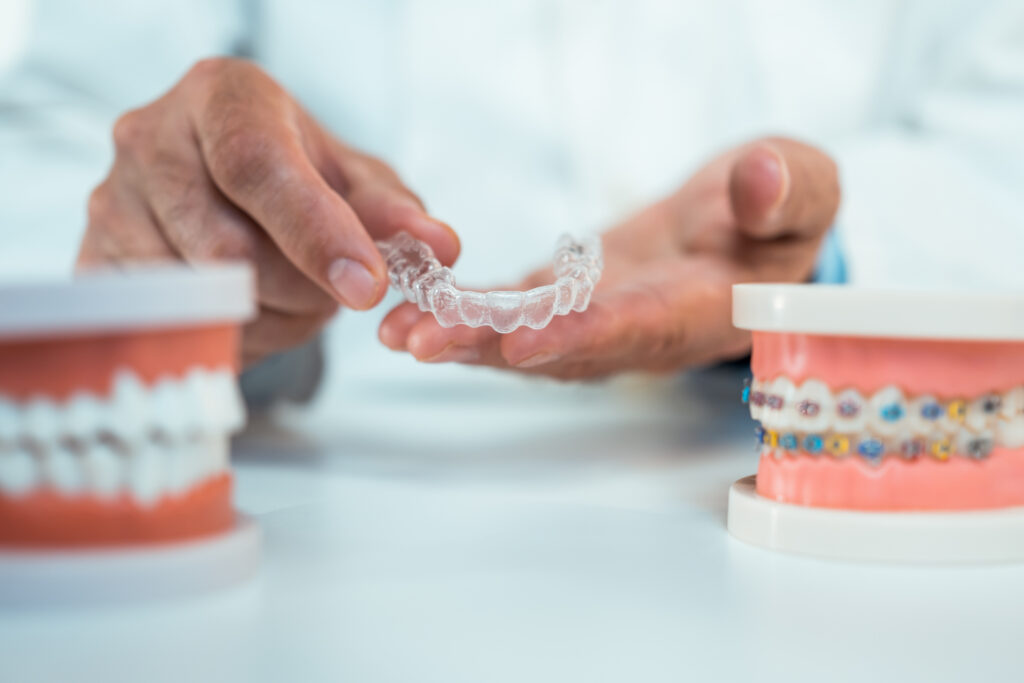Choosing the Right Orthodontic Treatment for Your Smile
Often the beginning of a beautiful, confident smile is well positioned teeth. Orthodontic treatments include Invisalign and conventional braces can help you get a straighter smile whether your problems are with gaps, crooked teeth, or bite concerns. But given two main choices—traditional braces and Invisalign—how would you determine which one would be best for your or your child?
This article will go over the variations between different orthodontic treatments, their advantages and drawbacks, and important considerations to make between them. By the end, you will see how knowledge of orthodontics from Dawson Dental may enable you to choose the optimal course for your smile.
Invisalign: The Clear Choice for Discreet Teeth Straightening
With its transparent, removable aligners that straighten teeth without metal brackets or wires, Invisalign has transformed orthodontic treatment. This procedure uses a set of translucent, custom-made trays meant to gently move your teeth into position over time.
Key Benefits of Invisalign
- Discreet Appearance: Since the transparent aligners are almost invisible, adults and teenagers who want a subdued approach often choose Invisalign.
- Comfortable Fit: The custom-made, smooth aligners suit your teeth, hence lessening of the gum and cheek discomfort.
- Removable Convenience: Better dental hygiene and less food limitations are made possible by easy removal of the aligners for eating, drinking, brushing, flossing.
- Lifestyle-Friendly: For people who engage in sports, public speaking, or other events where conventional braces would be impractical, Invisalign fits well into hectic schedules.
Best Suited For
Invisalign is ideal for mild to moderate orthodontic issues, such as:
- Slightly crooked or misaligned teeth
- Small gaps between teeth
- Minor bite corrections
Traditional Braces: Tried-and-True Orthodontic Care
For many years, traditional braces have been the dependable orthodontic fix. They consist of metal braces fastened to the teeth and wire connections frequently adjusted to guide the teeth into alignment. Modern braces are less noticeable and more comfortable than they were a few years thanks to technological developments.
Key Benefits of Traditional Braces
- Effective for Complex Cases: Braces can correct severe misalignments, overbites, underbites, and other complex dental issues.
- Constant Treatment: Unlike Invisalign, braces work 24/7 since they cannot be removed, ensuring consistent progress.
- Durability: Made from strong materials, traditional braces are highly durable and effective for younger patients.
- Variety of Options: Modern braces come in metal, ceramic, and even lingual options (placed behind the teeth), offering more choices than ever.
Best Suited For
Traditional braces are recommended for:
- Severe misalignment or bite issues
- Younger children and teens who may not be disciplined with removable aligners
- Patients needing significant tooth movement

Invisalign vs. Braces: A Side-by-Side Comparison
When deciding between Invisalign and traditional braces, it helps to consider several factors. Here’s a comparison table to highlight key differences:
| Criteria | Invisalign | Traditional Braces |
| Appearance | Clear, nearly invisible | Visible metal or ceramic brackets |
| Comfort | Smooth plastic aligners | Brackets and wires may cause irritation |
| Removability | Removable for eating and cleaning | Fixed; cannot be removed |
| Treatment Duration | 12-18 months (varies) | 18-24 months (varies) |
| Effectiveness | Best for mild to moderate cases | Suitable for mild to severe cases |
| Maintenance | Easy to clean; remove for brushing | Requires careful cleaning around brackets |
| Cost | Generally higher | More affordable, but cost varies by case |
Making the Best Decision for Your Smile
Choosing between Invisalign and traditional braces ultimately depends on your specific needs, lifestyle, and budget. Here are some factors to consider:
- Orthodontic Complexity:
- For mild to moderate cases, Invisalign offers a discreet and convenient solution.
- For complex cases, traditional braces provide a more effective and reliable option.
- Lifestyle Preferences:
- If you prefer a removable, nearly invisible treatment, Invisalign may be the better choice.
- If you want a constant, worry-free solution, braces might suit you best.
- Budget Considerations:
- Traditional braces generally cost less than Invisalign. However, financing options can make either treatment accessible.
The best way to determine the right treatment is through a professional consultation. At Dawson Dental, our experienced team can assess your needs and help you decide on the best orthodontic treatment for your smile.
A professional consultation is the best approach to decide on appropriate therapy. Our knowledgeable staff at Dawson Dental can carefully evaluate your requirements and guide you toward the ideal orthodontic correction for your smile, suggesting simply the best orthodontic treatment tailored to your special self.
Expert Orthodontic Care at Dawson Dental
Whether you decide on Invisalign or conventional braces, Dawson Dental is dedicated to providing first-rate orthodontic treatments. To provide exceptional outcomes, our team of knowledgeable experts employs modern technologies and customized treatment regimens.
- Personalized Care: Each patient receives a customized treatment plan tailored to their needs.
- Advanced Techniques: We use the latest innovations in orthodontics for optimal outcomes.
- Flexible Financing: We offer payment plans to make your orthodontic journey stress-free.
Starting today, move toward a straighter, better grin. Make an appointment with Dawson Dental to learn the best course of action towards your ideal smile!
FAQs About Invisalign and Traditional Braces
1. Is Invisalign more expensive than braces?
Each particular case is very much individual, so the price. Hence, Invisalign does not necessarily tend to be more expensive than traditional braces. Please note, Dawson Dental offers flexible financing options to make both treatments accessible.
2. Can Invisalign treat severe orthodontic cases?
Invisalign is most effective for mild to moderate cases. Severe misalignments or complex bite issues are typically better addressed with traditional braces.
3. How long does it take to straighten teeth with braces or Invisalign?
Invisalign usually takes 12–18 months, while traditional braces can take 18–24 months. The exact duration depends on the complexity of the case.
4. Are braces better for children than Invisalign?
Traditional braces are often recommended for children and teens because they are fixed in place, eliminating the risk of losing or forgetting aligners.
5. How often do I need to visit the dentist during treatment?
For both Invisalign and traditional braces, regular check-ups every 4–6 weeks are necessary to monitor progress and make adjustments.
This article will assist you in deciding which of Invisalign and conventional braces to wear. Plan your consultation at Dawson Dental right now for individualised guidance and professional orthodontic treatment!

